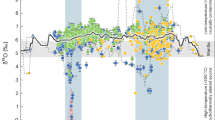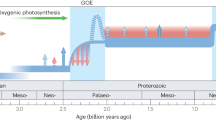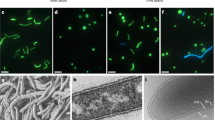Abstract
THE Oparin–Haldane hypothesis about the origin of life has provided a rational theoretical model for laboratory research. Almost thirty years of experiments have supported this hypothesis. Verification of the hypothesis in terrestrial environments, however, has not been documented. Some environments such as thermal springs in the Kuril Islands have been reported to have possible chemical precursors but lack of sterility and other factors have not made it possible to establish evidence for natural, terrestrial abiotic synthesis1. We identify here the Atlantis II Deep brine as a promising site for searching for chemical precursors, report finding thiocyanate in the brine and suggest a relationship between chemical evolution and the evolution of the Earth's crust.
This is a preview of subscription content, access via your institution
Access options
Subscribe to this journal
Receive 51 print issues and online access
$199.00 per year
only $3.90 per issue
Buy this article
- Purchase on Springer Link
- Instant access to full article PDF
Prices may be subject to local taxes which are calculated during checkout
Similar content being viewed by others
References
Mukhin, L. Nature 251, 50–51 (1974).
Ingmanson, D. E. & Dowler, M. J. Origins of Life 8, 221–224 (1977).
Watson, S. W. & Waterbury, J. B. in Hot Brines and Recent Heavy Metal Deposits in the Red Sea (eds Degens, E. T. & Ross, D. A.) 272–281 (Springer, New York, 1969).
Swinnerton, J. W. & Linnenbom, V. J. in Hot Brines and Recent Heavy Metal Deposits in the Red Sea (eds Degens, E. T. & Ross, D. A.) 251–253 (Springer, New York, 1969).
Brewer, P. G., Densmore, C. D., Munns, R. & Stanley, R. J. in Hot Brines and Recent Heavy Metal Deposits in the Red Sea (eds Degens, E. T. & Ross, D. A.) 138–147 (Springer, New York, 1969).
Ryan, W. B. F., Thorndike, E. M., Ewing, M. & Ross, D. A. in Hot Brines and Recent Heavy Metal Deposits in the Red Sea (eds Degens, E. T. & Ross, D. A.) 153–157 (Springer, New York, 1969).
Lederer, M. Science 110, 115–116 (1949).
Urban, P. J. Z. analyt. Chem. 179, 415–422 (1961).
Kaplan, I. R., Sweeney, R. E. & Nissenbaum, A. in Hot Brines and Recent Heavy Metal Deposits in the Red Sea (eds Degens, E. T. & Ross, D. A.) 474–498 (Springer, New York, 1969).
Stephens, J. D. & Wittkopp, R. W. in Hot Brines and Recent Heavy Metal Deposits in the Red Sea (eds Degens, E. T. & Ross, D. A.) 441–447 (Springer, New York, 1969).
Miller, S. L. Biochim. biophys. Acta 23, 480–489 (1957).
Ferris, J. P. & Joshi, P. C. Science 201, 361–363 (1978).
Kvenholden, K. A. et al. Nature 228, 923–926 (1970).
Author information
Authors and Affiliations
Rights and permissions
About this article
Cite this article
DOWLER, M., INGMANSON, D. Thiocyanate in Red Sea brine and its implications. Nature 279, 51–52 (1979). https://doi.org/10.1038/279051a0
Received:
Accepted:
Issue Date:
DOI: https://doi.org/10.1038/279051a0
This article is cited by
-
Did Salts in Seawater Play an Important Role in the Adsorption of Molecules on Minerals in the Prebiotic Earth? The Case of the Adsorption of Thiocyanate onto Forsterite-91
Origins of Life and Evolution of Biospheres (2023)
-
Kinetics of Thiocyanate Formation by Reaction of Cyanide with Tetrathionate
Aquatic Geochemistry (2021)
-
Unexpected Thiocyanate Adsorption onto Ferrihydrite Under Prebiotic Chemistry Conditions
Origins of Life and Evolution of Biospheres (2020)
-
Kinetics of Thiocyanate Formation by Reaction of Cyanide and Its Iron Complexes with Thiosulfate
Aquatic Geochemistry (2019)
-
Multiple sulfur isotopes fractionations associated with abiotic sulfur transformations in Yellowstone National Park geothermal springs
Geochemical Transactions (2014)
Comments
By submitting a comment you agree to abide by our Terms and Community Guidelines. If you find something abusive or that does not comply with our terms or guidelines please flag it as inappropriate.



